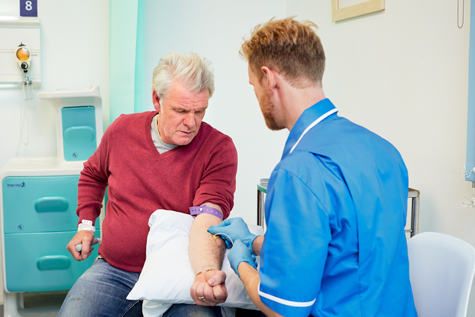Blood and body tissue samples are vital for cancer research. This page is about giving samples as part of a trial. There is information about
Blood and tissue samples in cancer research
You usually have a sample of blood taken from a vein in your arm. Where possible, blood samples for research are taken at the same time as routine blood tests.
A tissue sample is a sample of cells removed from your cancer. You might have this taken as part of a biopsy  when you are diagnosed. Or when you have an operation to remove your cancer.
when you are diagnosed. Or when you have an operation to remove your cancer.
Doctors and researchers look at blood and tissue samples in the laboratory
They use these samples to learn more about:
- how cancers develop so they can find new ways to prevent them
- changes in hormones, chemicals or cells to help find new ways to diagnose cancer
- how cancer cells behave so they can find new ways to kill them
- how new treatments affect cancer cells
- which treatments work best for people with particular types of cancer
- new ways to monitor cancer
- better ways of controlling side effects and symptoms
Collecting samples
The research team need to take blood or tissue samples before you start treatment. This is to make sure the trial is suitable for you. Many clinical trials are designed to test treatments for people with a specific type of cancer. And some are designed to test treatments that only work for people with cancers that produce certain proteins or chemical markers.
Your doctor or nurse ask your permission before taking samples for research. They give you some written information about taking the samples. The written information tells what will happen to your sample. The team ask you to sign a form giving consent. You’ll have a chance to ask them any questions you may have.
Some clinical trials also include plans to collect samples of blood or tissue for future research. This is nearly always optional. You can say no to this part of the research if you don’t want to give these samples. It won’t affect you taking part in the main trial.
People who do not have cancer, or any other illness, may also be asked to donate blood or tissue samples. Researchers can use these to find differences between healthy cells and cancer cells.
Other types of samples
Researchers can use different types of samples to help with their research. These include:
- fluids removed using a needle and syringe from joints, abscesses
 or cysts
or cysts 
- fluid build up from around the tummy (called ascites
 ) or around the lungs (pleural effusion
) or around the lungs (pleural effusion  )
)
- urine, spit (sputum), saliva and tears
- cells from skin, hair, nails, the inside of the mouth, the eye, or the neck of the womb (cervix)
- poo samples to look at the microbiome

What happens to your sample
Researchers store samples in laboratories called biobanks. These are like libraries. They keep the samples with some details of your medical history, but no personal details. The samples cannot be traced back to you. A computer stores the medical information about each sample. This is so that researchers can find the samples they need.
Related information
We have information about
 when you are diagnosed. Or when you have an operation to remove your cancer.
when you are diagnosed. Or when you have an operation to remove your cancer. or
or 
 ) or around the lungs (
) or around the lungs ( )
)





